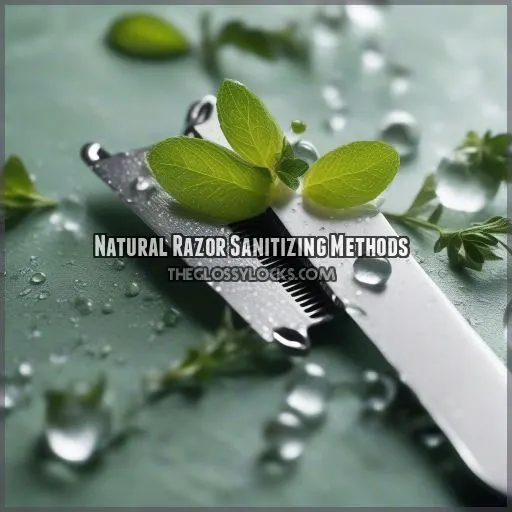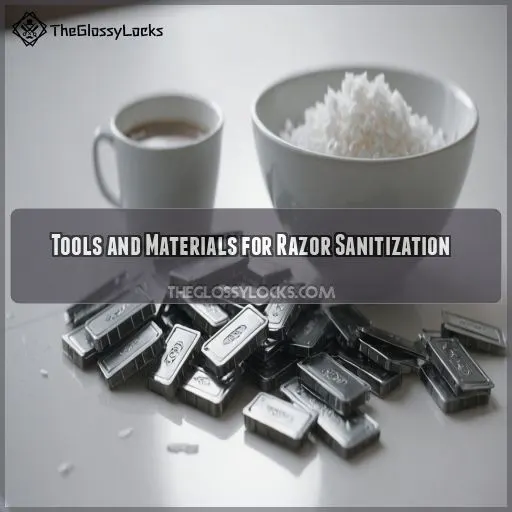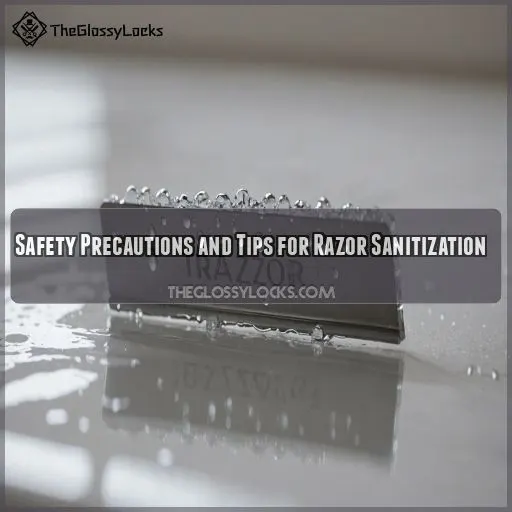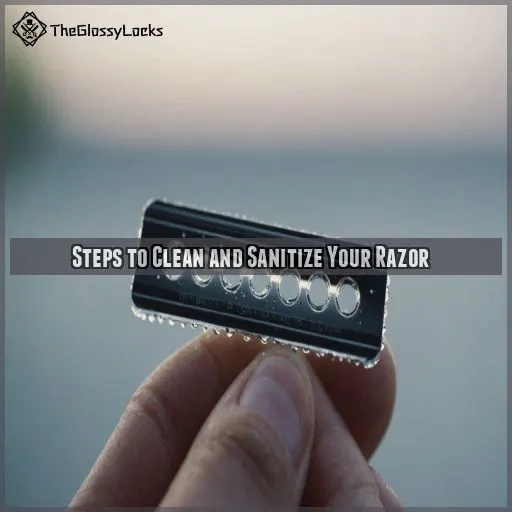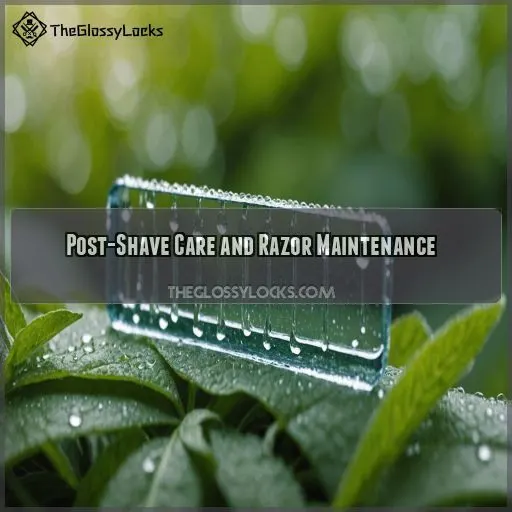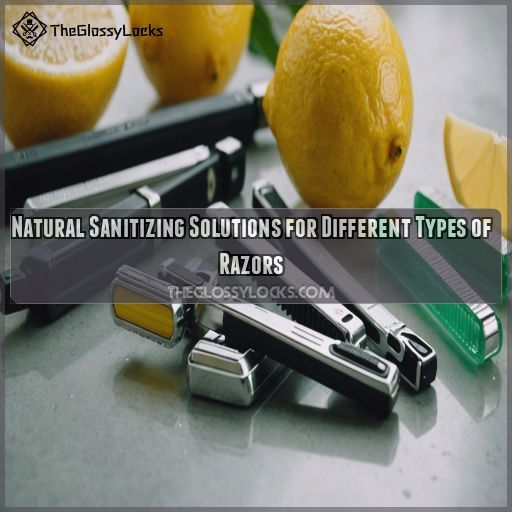This site is supported by our readers. We may earn a commission, at no cost to you, if you purchase through links.

Just rinse your razor under hot water before and after each shave – it’s like a mini spa treatment for your razor!
For an extra dose of hygiene, you can whip up a quick sanitizing solution with some rubbing alcohol or hydrogen peroxide.
Heck, even good ol’ white vinegar will do the trick.
Just let your razor soak for a bit, rinse, and you’re ready to tackle that stubble with confidence.
Your skin (and your razor) will thank you.
Table Of Contents
- Key Takeaways
- Natural Razor Sanitizing Methods
- Tools and Materials for Razor Sanitization
- Choosing the Right Sanitizing Solution
- DIY Natural Sanitizing Solutions for Razors
- Safety Precautions and Tips for Razor Sanitization
- Steps to Clean and Sanitize Your Razor
- Effective Shaving Techniques for Reduced Bacterial Growth
- Post-Shave Care and Razor Maintenance
- Best Practices for Storing and Handling Razors
- Natural Sanitizing Solutions for Different Types of Razors
- Frequently Asked Questions (FAQs)
- How do you sterilize razor blades at home?
- What is the best way to disinfect a shaver?
- How do I keep bacteria off my razor?
- Can you disinfect razor with vinegar?
- How frequently should razors be naturally sterilized?
- Can natural methods replace commercial sanitizers?
- Do natural methods ensure blade longevity?
- Are natural sterilization methods environmentally friendly?
- Can essential oils be used for sterilizing razors?
- Conclusion
Key Takeaways
- Whip up a quick sanitizing solution with rubbing alcohol, hydrogen peroxide, or white vinegar – it’s like giving your razor a mini spa treatment.
- Gather the right tools, like a soft-bristled brush and mild soap, to thoroughly clean and disinfect your razor, keeping it fresh and ready for a smooth shave.
- Rinse your razor before and after each use, brush it to remove grime, and let it fully air-dry to prevent rust – your skin will thank you for the TLC.
- Sanitize your razor weekly, replace blades regularly, and handle it safely to extend its lifespan and enjoy a hassle-free shaving experience.
Natural Razor Sanitizing Methods
When you sterilize your razor blades naturally, you’re keeping your skin happy and also showing the planet some love . Using eco-friendly solutions like vinegar or tea tree oil makes it easy to keep your razors clean without resorting to harsh chemicals.
Benefits of Natural Sanitizing Solutions
Natural sanitizing solutions offer eco-friendly, skin-friendly alternatives to harsh chemicals. You’ll enjoy the cost-effectiveness and long-term savings of DIY razor sterilization. Plus, these gentle options help maintain your razor’s performance and keep your skin healthy. It’s a win-win for your hygiene and wallet!
Popular Natural Sanitizing Options for Razors
Let’s talk about popular natural sanitizing options for razors. You can grab white vinegar – it’s eco-friendly and effective – or try tea tree oil for its antimicrobial zing. Don’t forget hydrogen peroxide; it knocks out bacteria like a pro! These natural sanitizers make razor cleaning a breeze while ensuring blade care without environmental impact.
Tools and Materials for Razor Sanitization
For keeping your razor clean and germ-free, having the right tools and materials makes all the difference. A little soap and a trusty toothbrush might seem like you’re prepping for oral hygiene, but these are your trusty allies in razor sanitization.
Essential Tools for Cleaning and Sanitizing Razors
Moving from natural methods, let’s gear up with a razor brush, some soap, warm water, and rubbing alcohol to sterilize your razor blades naturally. Don’t forget a cleaning cloth for drying—because nobody likes a rusty shave!
Best Materials for Effective Razor Sanitization
Gather the essentials – mild soap, soft brush, and rubbing alcohol. These simple materials work wonders for thoroughly cleaning and disinfecting your razor, keeping it fresh and ready for a smooth shave.
Tips for Preparing Your Razor for Sanitization
Alright, let’s get your razor blades prepped for their spa day! Before you naturally sterilize your razor, follow these tips:
- Blade Inspection: Check for dullness.
- Water Rinsing: Give your razor a splash.
- Tool Selection: Ready your cleaning kit.
- Storage Practices: Have a dry place ready.
Choosing the Right Sanitizing Solution
When choosing how to sanitize your razor, it’s all about balancing effectiveness and skin sensitivity. Whether you’re reaching for trusty rubbing alcohol or experimenting with tea tree oil, finding that sweet spot makes sure you get a clean shave without turning your bathroom into a science lab.
Rubbing Alcohol as a Sanitizing Agent
Before making sure the concentration of rubbing alcohol is at least 70% when sterilizing razor blades, it’s like giving your razor a shotquick, effective, and ready for action!
Hydrogen Peroxide as a Sanitizing Agent
Hydrogen peroxide is a powerful antiseptic that kills bacteria on your razor blades. Just be careful with the concentration – too strong can irritate skin. Give it a try!
White Vinegar as a Natural Sanitizing Agent
While hydrogen peroxide works wonders, switching to white vinegar offers an eco-friendly choice. It’s great for cleaning razors and blade maintenance. Just watch out for its less potent germ-fighting abilities.
Tea Tree Oil as a Natural Antimicrobial Agent
Much like a superhero, tea tree oil fights bacteria. Stir in a few drops for blade sterilization. However, if you’re sensitive, consider tea tree oil alternatives for safety.
DIY Natural Sanitizing Solutions for Razors
Keeping your razors clean naturally doesn’t have to be complicated or involve harmful chemicals. With a few common household items, you can create effective homemade solutions that keep your razors in great condition and your skin happy.
Making a Natural Sanitizing Solution With Rubbing Alcohol
Whip up a quick sanitizing solution with 70% rubbing alcohol. Just mix it in a spray bottle, mist your razor, and let it air-dry. Easy peasy!
- Mix 70% rubbing alcohol in a spray bottle.
- Mist your razor with the solution.
- Allow the razor to fully air-dry.
Creating a Natural Sanitizing Solution With Hydrogen Peroxide
Switching gears from rubbing alcohol, try hydrogen peroxide. Use a 1:1 ratio with water. It’s simple, safe, and eco-friendly. Here’s a quick guide:
| Concentration | Mixing Ratio | Safety Tips | Storage Duration |
|---|---|---|---|
| 3% | 1:1 | Wear gloves, avoid ingestion | Store for 1 month |
| 6% | 1:2 | Avoid eyes, ventilate area | Store for 2 months |
Using White Vinegar as a Natural Sanitizing Solution
When you’re in a pickle, white vinegar‘s your go-to for a simple razor clean-up. It’s effective, natural, and a breeze to use. Just soak, rinse, and dry!
Combining Natural Ingredients for Enhanced Sanitizing
Mix up your very own DIY razor sanitizer with essential oils, vinegar & alcohol. A splash of apple cider vinegar offers natural antiseptics, keeping your razor happy and hygienically sound!
Safety Precautions and Tips for Razor Sanitization
Proper handling and storage of your razor is really important to prevent cross-contamination and maintain good hygiene. Follow these simple tips to extend the lifespan of your razor and enjoy a smoother, more comfortable shave every time.
Proper Handling and Storage of Razors
To keep razor hygiene on point, store your blades wisely. Consider these tips:
- Use airtight storage containers for rust prevention.
- Secure blades in travel kits.
- Dispose properly.
Avoiding Cross-Contamination During Sanitization
Imagine you’re in a kitchen, balancing plates. Use separate tools, dedicated surfaces, and clean hands to avoid cross-contamination. Grab disposable wipes or a drying method for extra hygiene.
Frequency of Razor Sanitization for Optimal Results
Folks, think of razor sanitization like brushing your teeth—do it regularly! Aim for a weekly clean to avoid skin irritation, reduce infection risk, and keep your blade’s lifespan healthy.
Tips for Extending the Lifespan of Your Razor
To extend your razor’s lifespan, store it upright to prevent rust, replace blades every 5-10 shaves, and sanitize weekly with rubbing alcohol. Your skin will thank you!
Steps to Clean and Sanitize Your Razor
When it’s time to clean and sanitize your razor, you don’t need to play detective. Rinse, brush, dry, and disinfect, and soon you’ll be shaving so smoothly that your razor might need a day off!
Rinsing Your Razor Before and After Use
Rinsing your razor enhances blade lifespan. Use warm water; it’s your razor’s best buddy. Pre-shave, give it a quick dash. Post-shave, rinse thoroughly for excellent razor hygiene.
Brushing and Cleaning Your Razor for Deep Sanitization
Grab a toothbrush or razor brush! Regular brushing removes grime from hard-to-reach areas. Make sure you replace brushes periodically to maintain efficiency. Remember, it’s essential for razor hygiene!
Drying and Ventilating Your Razor for Rust Prevention
After rinsing, let your razor air-dry in a well-ventilated spot. Dab it with a towel to speed things up. Keeping it dry prevents rust and extends your blade’s lifespan.
Disinfecting and Sterilizing Your Razor for Maximum Hygiene
Now you’ve dried your razor, it’s time for some DIY sanitizer magic. Soak it in isopropyl alcohol or white vinegar for ultimate hygiene. Your razor’s lifespan will thank you!
Effective Shaving Techniques for Reduced Bacterial Growth
Keeping your razor clean while shaving can feel like a tough task, but moderate blade rinses between strokes are your trusty sidekick, fighting bacteria. Regular maintenance will help prevent irritation and make for a smoother shave, leaving your skin happier than a cat in a sunbeam.
Rinsing Your Razor Between Strokes for Reduced Bacteria
You’ve got to rinse your razor between strokes, buddy! This simple shaving tip reduces bacteria growth, supporting skin health and razor hygiene. Keep that cleanliness routine on point for smoother skin.
Maintaining Blade Sharpness for Reduced Irritation
Keep those blades sharp – it makes all the difference! Dull razors tug and pull, leaving your skin irritated. Hone those edges for a close, comfortable shave.
Preventing Razor Burn and Bumps for a Smoother Shave
Worried about razor burn? Start with pre-shave prep—cleanse and exfoliate. Shaving technique matters! Keep razor blades sharp, use gentle strokes, then follow up with soothing post-shave care. Stay smooth, my friend!
Tips for a Smooth Shaving Experience
After preventing razor burn and bumps, smooth shaving prep’s your next step.
. Keep that razor angle right, exfoliate skin gently, embrace post-shave balm, and make sure your blade is sharp for a hassle-free shave!
Post-Shave Care and Razor Maintenance
After shaving, give your razor a good rinse, like it’s been clamming up all day and needs a cool drink. Just like changing socks every day, replacing your razor regularly helps maintain a clean blade to keep your shaves fresh and irritation-free
.
Rinsing Your Razor Thoroughly After Shaving
After your shave, give your razor a thorough rinse under warm water. This helps flush away any lingering hair, shaving cream, or debris that could cause irritation or premature blade dulling. A quick post-shave clean keeps your razor in tip-top shape for the next use.
- Rinse thoroughly under warm water
- Remove any remaining hair or shaving cream
- Extend the lifespan of your razor blades by properly storing them.
Replacing Your Razor Blade for Optimal Performance
After rinsing your razor, consider replacing the blade before it loses its edge. A sharp blade reduces irritation and extends blade lifespan—no one likes feeling tugged like a dog on a leash! Replace blades when you notice dullness or razor pulling for a smoother shave.
| Blade Concern | When to Replace |
|---|---|
| Sharpness | After 5-10 shaves |
| Dullness | Immediately |
| Shaving Irritation | At first sign |
Best Practices for Storing and Handling Razors
Storing and handling your razor properly can prevent bacteria from crashing the party on your face and keep shaving a smooth, nick-free experience. Avoiding injuries and maintaining hygiene isn’t rocket science—just store your razor in a dry place, and treat it like you’d a guest at your dinner table.
Proper Storage of Razors for Reduced Bacterial Growth
Properly storing your razor is like giving it a cozy little bed. Try these tips:
- Use razor storage containers.
- Control humidity.
- Make sure there’s good airflow.
- Choose a dry storage location.
Handling Razors Safely to Avoid Injury
Carefully grasp your razor to prevent nicks and cuts. Avoid touching the blade directly – use the handle for safe maneuvering. Dispose of used blades in a secure container.
| Razor Handling Tip | Benefit |
|---|---|
| Use the handle, not the blade | Prevents accidental cuts |
| Grip firmly but gently | Maintains control, avoids slips |
| Store blades in a protective case | Safeguards against injury |
| Discard used blades properly | Eliminates sharp edge hazards |
| Keep work area clear and organized | Reduces risk of mishaps |
Cleaning and Sanitizing Razors After Use
It’s time to focus on razor hygiene! After safely handling your razor, make sure you prevent infection by using these DIY solutions:
- Rinse thoroughly
- Air dry completely
- Disinfect regularly
- Store safely
Tips for Safe and Hygienic Razor Handling
You’ve cleaned your razor, now handle it like a pro! Imagine your razor’s a sleeping dragon: respect its space, keep it safe, and enjoy smoother shaves!
| Razor Safety | Handling Tips |
|---|---|
| Use a guard | Prevents accidents |
| Dry after use | Stops rust formation |
| Store upright | Encourages drainage |
| Replace often | Maintains sharpness |
| Clean weekly | Boosts hygiene |
Natural Sanitizing Solutions for Different Types of Razors
Naturally sanitizing your razor blades is simpler than you might think and it doesn’t involve any fancy potions or spells. With just a few common household items, like white vinegar or tea tree oil, you’ll keep those blades pristine and give your skin the safe shave it deserves.
Sanitizing Cartridge Razors With Natural Solutions
Sanitize your cartridge razor naturally by soaking it in a homemade vinegar solution. This eco-friendly mix keeps blades sharp and bacteria-free for a close, comfortable shave.
Sanitizing Safety Razors With Natural Solutions
If you’re looking to keep your safety razor squeaky clean, natural sanitizing solutions are your best bet. Consider these eco-friendly choices:
- Hydrogen peroxide
- White vinegar
- Tea tree oil
Sanitizing Straight Razors With Natural Solutions
Straight razors demand special care. Use natural razor sanitizers like vinegar or tea tree oil. Gently cleanse the blade with DIY solutions, ensuring a close shave every time. It’s straight-up essential!
Tips for Sanitizing Disposable Razors Naturally
Switching from straight to disposable razors? You’ve got this. Use natural sanitizers like vinegar for effectiveness. Embrace DIY solutions to extend your razor’s lifespan, ensuring every shave feels smooth.
Frequently Asked Questions (FAQs)
How do you sterilize razor blades at home?
Sanitize your razor blades naturally by soaking them in white vinegar or apple cider vinegar for a few minutes. The vinegar’s natural acidity kicks bacteria and grime to the curb, leaving your blades pristine and ready to go.
What is the best way to disinfect a shaver?
Keeping your shaver germ-free is a breeze! Just soak the heads in rubbing alcohol, your trusty germ warrior, for a few minutes. It kills bacteria faster than you can say "clean shave," ensuring your safety and freedom.
How do I keep bacteria off my razor?
To keep bacteria off your razor, rinse it thoroughly after each use, dry it completely, and store it in a dry place. Give your blades a weekly disinfecting soak in rubbing alcohol to kill any lingering germs.
Can you disinfect razor with vinegar?
You can disinfect your razor with vinegar. It’s like giving your razor a spa day! Soak it in white vinegar for about 10 minutes to remove bacteria and mineral deposits, though it’s not the strongest bacteria killer.
How frequently should razors be naturally sterilized?
Think of your razor as a trusty steed, needing care to gallop smoothly. Naturally sterilize it weekly with vinegar or hydrogen peroxide. This routine keeps hairy troubles at bay, makes sure safety, and guarantees a clean-cut experience.
Can natural methods replace commercial sanitizers?
You can totally rely on natural methods like hot water and alcohol to sanitize razors. They clear the air of germs, though commercial sanitizers might bring that extra sparkle of peace of mind.
Do natural methods ensure blade longevity?
Absolutely, natural methods can keep your blades sparkling and extend their lifespan. Just a quick swish in some trusty vinegar or alcohol, and you’re good to go – no harsh chemicals needed! Your skin will thank you.
Are natural sterilization methods environmentally friendly?
Going green with natural sterilization methods is like giving Mother Earth a high-five! They reduce your carbon footprint by using everyday items like vinegar or boiling water, making your shaving routine more eco-friendly and sustainable.
Can essential oils be used for sterilizing razors?
You can use essential oils like tea tree oil to sanitize your razors. Its natural antibacterial properties help keep those pesky germs at bay. Just remember, not everyone’s skin loves it, so test first!
Conclusion
Isn’t it a coincidence that achieving a hygienic shave starts with knowing how to sterilize razor blades naturally?
By using simple ingredients like rubbing alcohol, hydrogen peroxide, or white vinegar, you’re saving money but also protecting your skin.
With these easy steps for cleaning, storage, and maintenance, your razor will stay in great condition, and you’ll avoid pesky nicks and infections.

